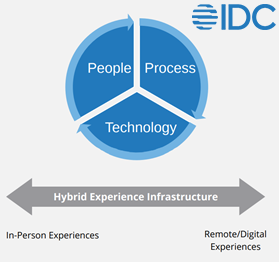Introducing IDC’s Hybrid-First Framework for Education
Stay-at-home orders in early 2020 locked 90% of the world’s students out of school – that’s roughly 1.3 billion students. This forced a rapid shift to online learning for millions of students, faculty, and staff that had little to no experience with digital learning, teaching, or administration. Initially a short-term solution to prevent the spread of COVID-19, schools are now entering their third consecutive pandemic-disrupted academic year, and hybrid learning and operations are still on-going.
Despite some initial challenges, 18 months of prolonged online and hybrid experiences in the classroom as well as in the back office have led to improvements in online pedagogy and significant advancements in education technology and service delivery that are likely to remain a permanent. To succeed moving forward, education leaders must redefine how they operate and prepare for a future where hybrid education experiences are the new normal. In other words, they must take a “hybrid-first approach” to institutional operations and service delivery. Hybrid-first is an approach that leverages a hybrid experience infrastructure to enable continuity of service regardless of physical location and to seamlessly shift between remote and in-person services.
Why Hybrid-First?
Taking a hybrid-first approach is essential for education institutions in the years ahead for three key reasons:
- Continuous disruption is the norm, not the exception – The COVID-19 pandemic was the most significant on-going disruption education institutions have faced. However, this pandemic will not be the last disruption. Other natural, manmade, technical, and business disruptions such as severe weather events, cyber security incidences, and swings in economic activity will continue to put pressure on institutions. To adapt, an emphasis on hybrid-first will empower institutions to seamlessly switch between in-person and remote experiences, regardless of the disruption.
- Students are demanding better digital learning experiences and flexibility – After realizing the benefits of remote and hybrid learning, many students and parents are demanding greater access to online and hybrid education programs moving forward. A hybrid-first approach enables institutions to design programs and services so that they can effectively serve the needs of constituents that want an in-person, remote, or hybrid experience at any point in their learning journey.
- Synergy between education and work has been lost – For decades, a common critique of the K-12 and Higher Education systems is that they often fail to prepare students for life and work after graduation. In recent years, these critiques have ramped up as emerging technologies such as AI and machine learning have increasingly replaced human skills and labor. This has resulted in a shift towards lifelong learning, where workers will find themselves weaving in and out of education and training programs throughout their careers to remain competitive. A hybrid-first approach enables education institutions to serve lifelong learners more effectively, regardless of their stage of life or career, by providing flexibility in where and when they access education programs and services.
Implementing the Hybrid-First Framework
These pressures are forcing education leaders to reimage what the future looks like for their institutions. They are now seeking ways to move beyond pandemic-era remote and hybrid experiments to develop a scalable and sustainable model; we dive deeper into the in IDC’s new eBook, A Framework to Develop Hybrid-First Experiences in Education.
IDC’s hybrid-first approach (see Figure 1) aims to solve this by helping institutions map existing connections between people, processes, and technologies across all touchpoints between front- (i.e. students, parents, private/nonprofit partners) and back-end (I.e. faculty, staff) users for all types of education experiences or engagements between both parties. Hybrid-first can be applied to back office, classroom, student, or campus experiences.

Outlining the people, processes, and technologies involved at each touchpoint can determine where there are operational bottlenecks, outdated paper-based processes, risk of consequential human error, disconnected systems or apps, or inefficient use of finite resources. This in turn will help institutions identify opportunities to invest in digital infrastructure to align the front- and back-end user experiences in one seamless workflow. In doing so, institutions can establish what IDC refers to as a “hybrid experience infrastructure”.
A simple example involves a college student setting up a meeting with their academic advisor. At the current state, the student has to email their advisor and ask for their availability. It may take several back-and-forth emails to set a time. The only way for the meeting to take place is in-person, so both parties must present in the advisor’s office. When checking in, the student must notify the front desk receptionist who then must notify the advisor. Then the two may finally meet.
By mapping out the steps, processes, and technologies involved, the college can identify where improvements can streamline the engagement. For example, the college may create a mobile app that gives students the ability to book an appointment with their advisor. Adopting a unified communications platform enables virtual appointments. When the meeting is set for virtual, the app automatically sends a calendar invite with a sign-in link for both parties. If the meeting is in person, students can check-in through the app and the advisor is notified on their screen.
Guidance for Building Hybrid-First Capabilities
Identify quick-win opportunities to implement hybrid-first – The hybrid-first approach provides education leaders with a framework to guide their institutions through digital transformations that enable hybrid experiences. Some of these changes will be simple, such as the example given above, while others will be more complex. By identifying quick-win solutions to serve as test cases for hybrid-first, institutions can build up the experience they need to tackle more complicated engagements.
Focus on “high-value” engagements that improve the front-end user experience – While quick-wins are essential, it is also critical that institutions focus on “high-value” engagements that are important to front-end users. For example, if students often complain about not being able to find a time to meet with their advisor when asked why they are struggling in their academic program, it is highly important for the institution to find ways to address that problem to ensure student success.
Continuously evaluate hybrid-first processes and make iterative improvements – It is natural for institutional leaders to want to make one-time improvements to processes and address all problems associated with an existing engagement. However, it can be difficult to account for all problems that might exist today, and it can be even more challenging to anticipate what new challenges may emerge when changes are made. Focus on the “minimum viable product” when initially making hybrid-first adjustments, and then continuously evaluate those processes to make iterative improvements over time.
While there were incredible challenges and massive learning curves to overcome, the benefits of hybrid operations and learning have been made clear, and education leaders are developing new ways to sustain this mode of learning for the long-term. However, the challenge is providing high quality hybrid experiences at scale. Join us for the webinar, “How Education Institutions Can Scale and Sustain Hybrid-First Experiences“, we will discuss IDC’s Hybrid-First framework for education, a new approach that leverages a hybrid experience infrastructure to enable continuity of service regardless of physical location and to shift seamlessly between remote and in-person services. Click the button below to register.




